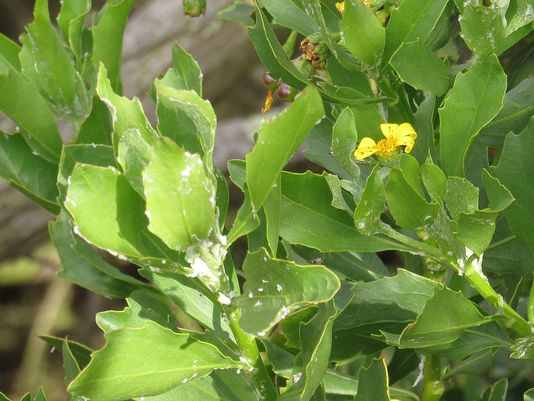What Does It Look Like?
What is it?
Boneseed (Chrysanthemoides monilifera subsp. monilifera) is a erect evergreen shrub, perennial being relatively short-lived (10-20 years), which grows up to 2-3 m high, reproducing (spreading) only by seed. It has woody branched stems. Leaves are 20–70 mm long, and 10–35 mm wide, shaped elliptic (broadest in the middle and equally narrow at both ends) to broadly elliptic to obovate (egg-shaped to triangular in outline with the widest part nearer the tip of the leaf), with irregularly serrated edges. Leaves are fresh green, thick and soft-leathery, with a obvious mid-vein. New growth is typically covered by white downy cotton-like material (hairs). Boneseed has a shallow root system. It can absorb moisture from light summer showers before it reaches the deeper rooting zone of other plants. This gives it a competitive advantage over deeper-rooted species, especially in areas of low summer rainfall (CRC 2003).
The inflorescence (flowers heads), are in groups of 3-12. Individual flower heads are up to 30 mm in diameter with each flower head with 5-8 fresh bright yellow petals around the edge and a deeper yellow centre, with peak flowering occurring from August to October. Each flower head is made up of many individual flowers crowded on to a receptacle at the end of the flower stalk. Flower heads are made up of two kinds of flowers, disc flowers (also known as tubular florets (or tubular flowers) in the centre that are the darker looking, and 5-8 ray (ligulate), flowers around the edge are the flower head that appear to be individual petals, but are in fact individual 'ray' flowers.
The fruit is round drupe (like a fleshy berry) to 8-9 mm in diameter across, fleshy green, turning black when mature, and contains a single smooth round seed 6-7 mm in diameter. The seed is bone coloured when dry, hence the name 'Boneseed' (CRC 2003).
Recognition: This species can normally be recognised by the combination of the following characters; Woody stems are branched and upright; Leaves are 20-70 mm long and alternate along the stems, egg-shaped with irregularly serrated edges are thick and soft-leathery. New growth is covered with white hairs; Flower heads are in groups of 3-12, yellow with 5-8 petals and up to 3 cm in diameter. Peak flowering occurs from August to October. Young fruit is round, green and fleshy and turn black when mature. They contain a single, smooth, round seed (6-7 mm diameter) which is bone-coloured when dry, giving rise to the name ‘boneseed’.
For further information and assistance with identification of Boneseed contact the herbarium in your state or territory.
Flower colour
Yellow
Growth form (weed type/habit)
Shrub
Where it currently grows? Preferred habitat
Boneseed grows under a wide range of climatic conditions but prefers sandy or medium-textured soils and disturbed situations, particularly near the sea because it tolerates salty conditions (CRC 2003). It prefers winter rainfall regions. Boneseed does not tolerate waterlogged conditions, and growth is inhibited by prolonged droughts and frosts (Brougham et al. 2006).
Are there similar species?
Boneseed can be confused with the closely related Bitou Bush (Chrysanthemoides monilifera subsp. rotundifolia). Boneseed differs from Bitou Bush by its upright growth habit (versus the sprawling habit of Bitou Bush), less rounded and more obviously toothed leaves, flowers with less petals. (5-8 for Boneseed versus 11-13 for Bitou Bush) and round, smooth seeds (versus usually smaller and darker egg-shaped ribbed seeds for Bitou Bush). Bitou Bush is also mainly confined to coastal areas with summer rainfall (Adair & Ainsworth 2000; Brougham et al. 2006).
Similar natives found in coastal habitats are:
Boobialla (Myoporum insulare) and Sea Box (Alyxia buxifolia). Both grow mostly on sea cliffs and have round or fleshy leaves. Boobialla is the most similar, with fleshy bright green leaves, white shortly tubular flowers spotted purple inside and succulent purple fruits. Sea Box has round leathery leaves, white flowers and red berries. Juvenile Boneseed in particular can be confused with seedlings of the Boobialla. However, Boneseed seedlings are covered in white downy hair while Boobialla seedlings are not (Brougham et al. 2006).
Hop Goodenia (Goodenia ovata), a weak shrub with thin, brown, erect stems, shiny, finely toothed leaves and bright yellow flowers mainly in spring to summer could also be confused with Boneseed. However, the flowers are 5-petalled, irregular and not daisy-like (DPI 2001).































